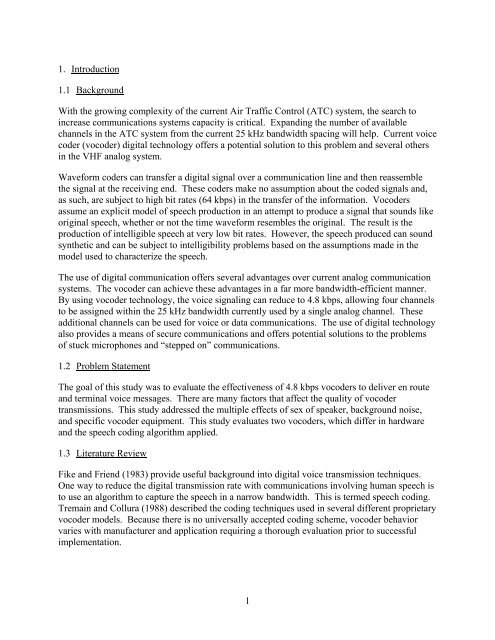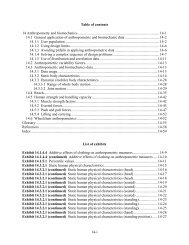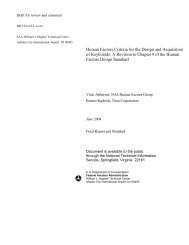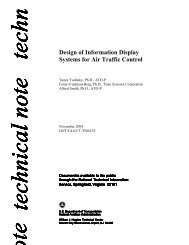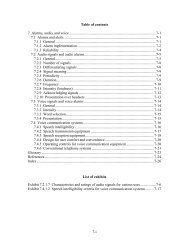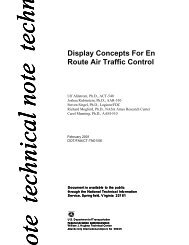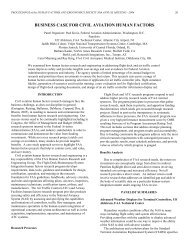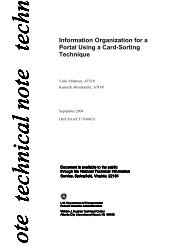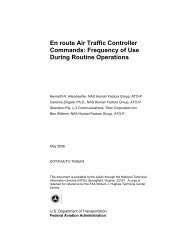Human Factors Evaluation of Vocoders for Air Traffic Control ... - FAA
Human Factors Evaluation of Vocoders for Air Traffic Control ... - FAA
Human Factors Evaluation of Vocoders for Air Traffic Control ... - FAA
Create successful ePaper yourself
Turn your PDF publications into a flip-book with our unique Google optimized e-Paper software.
1. Introduction<br />
1.1 Background<br />
With the growing complexity <strong>of</strong> the current <strong>Air</strong> <strong>Traffic</strong> <strong>Control</strong> (ATC) system, the search to<br />
increase communications systems capacity is critical. Expanding the number <strong>of</strong> available<br />
channels in the ATC system from the current 25 kHz bandwidth spacing will help. Current voice<br />
coder (vocoder) digital technology <strong>of</strong>fers a potential solution to this problem and several others<br />
in the VHF analog system.<br />
Wave<strong>for</strong>m coders can transfer a digital signal over a communication line and then reassemble<br />
the signal at the receiving end. These coders make no assumption about the coded signals and,<br />
as such, are subject to high bit rates (64 kbps) in the transfer <strong>of</strong> the in<strong>for</strong>mation. <strong>Vocoders</strong><br />
assume an explicit model <strong>of</strong> speech production in an attempt to produce a signal that sounds like<br />
original speech, whether or not the time wave<strong>for</strong>m resembles the original. The result is the<br />
production <strong>of</strong> intelligible speech at very low bit rates. However, the speech produced can sound<br />
synthetic and can be subject to intelligibility problems based on the assumptions made in the<br />
model used to characterize the speech.<br />
The use <strong>of</strong> digital communication <strong>of</strong>fers several advantages over current analog communication<br />
systems. The vocoder can achieve these advantages in a far more bandwidth-efficient manner.<br />
By using vocoder technology, the voice signaling can reduce to 4.8 kbps, allowing four channels<br />
to be assigned within the 25 kHz bandwidth currently used by a single analog channel. These<br />
additional channels can be used <strong>for</strong> voice or data communications. The use <strong>of</strong> digital technology<br />
also provides a means <strong>of</strong> secure communications and <strong>of</strong>fers potential solutions to the problems<br />
<strong>of</strong> stuck microphones and “stepped on” communications.<br />
1.2 Problem Statement<br />
The goal <strong>of</strong> this study was to evaluate the effectiveness <strong>of</strong> 4.8 kbps vocoders to deliver en route<br />
and terminal voice messages. There are many factors that affect the quality <strong>of</strong> vocoder<br />
transmissions. This study addressed the multiple effects <strong>of</strong> sex <strong>of</strong> speaker, background noise,<br />
and specific vocoder equipment. This study evaluates two vocoders, which differ in hardware<br />
and the speech coding algorithm applied.<br />
1.3 Literature Review<br />
Fike and Friend (1983) provide useful background into digital voice transmission techniques.<br />
One way to reduce the digital transmission rate with communications involving human speech is<br />
to use an algorithm to capture the speech in a narrow bandwidth. This is termed speech coding.<br />
Tremain and Collura (1988) described the coding techniques used in several different proprietary<br />
vocoder models. Because there is no universally accepted coding scheme, vocoder behavior<br />
varies with manufacturer and application requiring a thorough evaluation prior to successful<br />
implementation.<br />
1


